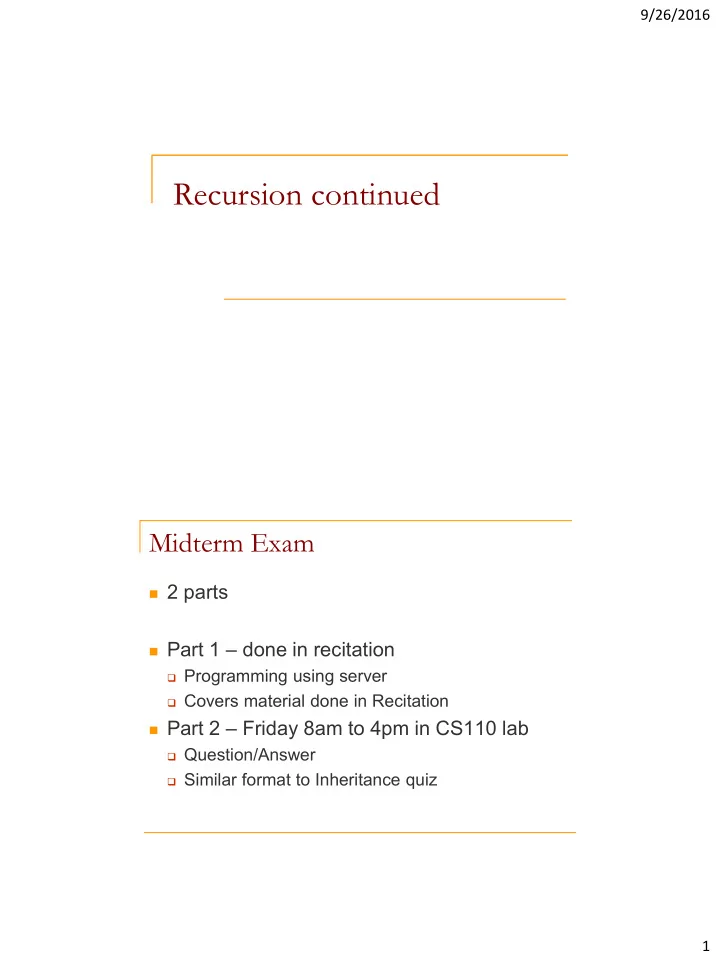

9/26/2016 Recursion continued Midterm Exam 2 parts Part 1 – done in recitation Programming using server Covers material done in Recitation Part 2 – Friday 8am to 4pm in CS110 lab Question/Answer Similar format to Inheritance quiz 1
9/26/2016 Fibonacci’s Rabbits Suppose a newly-born pair of rabbits, one male, one female, are put on an island. A pair of rabbits doesn’t breed until 2 months old. Thereafter each pair produces another pair each month Rabbits never die. How many pairs will there be after n months? image from: http://www.jimloy.com/algebra/fibo.htm 3 Do some cases, see a pattern? m0: 1 young 1 m1: 1 mature 1 m2: 1 mature 1 young 2 m3: 2 mature 1 young 3 m4: 3 mature 2 young 5 m5: 5 mature 3 young 8 m6? 2
9/26/2016 The pattern... m0: 1 young 1 m1: 1 mature 1 m2: 1 mature 1 young 2 m3: 2 mature 1 young 3 m4: 3 mature 2 young 5 m n = m n-1 (rabbits never die) + m n-2 (newborn pairs) How fast does this rabbit population grow? Fibonacci numbers The Fibonacci numbers are a sequence of numbers F 0 , F 1 , ... F n defined by: F 0 = F 1 = 1 F i = F i -1 + F i -2 for any i > 1 Write a method that, when given an integer i , computes the nth Fibonacci number. 3
9/26/2016 Fibonacci numbers recursive Fibonacci was expensive because it made many, many recursive calls fibonacci(n) recomputed fibonacci(n-1, ... ,1) many times in finding its answer! this is a common case of "overlapping subproblems ”, where the subtasks handled by the recursion are redundant with each other and get recomputed 7 Fibonacci code Let's run it for n = 1,2,3,... 10, ... , 20,... What happens if n = 5, 6, 7, 8, ... Every time n increments with 2, the call tree more than doubles.. F5 F4 F3 F2 F1 F2 F3 F0 F1 F1 F2 F1 F0 F0 F1 4
9/26/2016 Growth of rabbit population 1 1 2 3 5 8 13 21 34 ... every 2 months the population at least DOUBLES Recursive Algorithms Example: Tower of Hanoi, move all disks to third peg without ever placing a larger disk on a smaller one. 10 5
9/26/2016 Try to find the pattern by cases One disk is easy Two disks... Three disks... Four disk... Recursive Algorithms Example: Tower of Hanoi, move all disks to third peg without ever placing a larger disk on a smaller one. 12 6
9/26/2016 Recursive Algorithms Example: Tower of Hanoi, move all disks to third peg without ever placing a larger disk on a smaller one. 13 Recursive Algorithms Example: Tower of Hanoi, move all disks to third peg without ever placing a larger disk on a smaller one. 14 7
9/26/2016 Recursive Algorithms Example: Tower of Hanoi, move all disks to third peg without ever placing a larger disk on a smaller one. 15 Parade A parade consists of a set of bands and floats in a single line. To keep from drowning each other out, bands cannot be placed next to another band Given the parade is of length n, how many ways can it be organized 8
9/26/2016 Counting ways Let P(n) = the number of ways the parade can be organized. Parades can either end in a band or a float Let F(n) = the number of parades of length n ending in a float Let B(n) = the number of parades of length n ending in a band So: P(n) = F(n) + B(n) Recursive case Consider F(n) Since a float can be placed at next to anything, the number of parades ending in a float is equal to F(n) = P(n-1) Consider B(n) The only way a band can end a parade is if the next to last unit is a float. B(n) = F(n-1) By substitution, B(n) = P(n-2) So: P(n) = P(n-1) + P(n-2) 9
9/26/2016 Base case How many parades configs can there be for: n=1 2 – float or band How many parade configs can there be for : n=2 3 Float/float Band/float Float/band Dictionary lookup Suppose you’re looking up a word in the dictionary (paper one, not online!) You probably won’t scan linearly thru the pages – inefficient. What would be your strategy? 10
9/26/2016 Binary search binarySearch(dictionary, word){ if (dictionary has one page) { // base case scan the page for word } else { // recursive case open the dictionary to a point near the middle determine which half of the dictionary contains word if (word is in first half of the dictionary) { binarySearch(first half of dictionary, word) } else { binarySearch(second half of dictionary, word) } } Binary search Write a method binarySearch that accepts a sorted array of integers and a target integer and returns the index of an occurrence of that value in the array. If the target value is not found, return -1 index 0 1 2 3 4 5 6 7 8 9 10 11 12 13 14 15 16 value -4 2 7 10 15 20 22 25 30 36 42 50 56 68 85 92 103 int index = binarySearch(data, 42); // 10 int index2 = binarySearch(data, 66); // -1 11
Recommend
More recommend